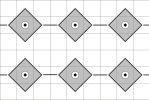bonecollector777
Well-Known Member
- Joined
- Oct 7, 2012
- Messages
- 142
Fairly new to the reloading game but have learned a lot reading here and from some friends. Working up a load for a new 28 nosler. 175 grain berger elite hunter with retumbo. 1:8 twist. Currently 0.015" off lands. Did a ladder test and saw some promising nodes so started around there. Now I'm here with these 2 groups. 80.5 grains gave me the 3 in the same vertical line with SD of 5 and ES of 10 and grouped right at 1.000" at 100 yards( I know 3 shots isn't much to go off of on SD and ES but that's what I got so far.) 80.4grains gave me the more triangle shaped group with and SD of 10 and ES of 20 and grouped at .800" at 100 yards.
My question is are those acceptable numbers to start playing with seating depth or need to go back and find a better node? As a general rule what do you find acceptable before you start messing with seating depth?
Gun has a heavy sporter barrel but no brake so certainly the shooter trying to tame this beast could be a factor on group size. Gun cooled down 4 minutes between shots.


My question is are those acceptable numbers to start playing with seating depth or need to go back and find a better node? As a general rule what do you find acceptable before you start messing with seating depth?
Gun has a heavy sporter barrel but no brake so certainly the shooter trying to tame this beast could be a factor on group size. Gun cooled down 4 minutes between shots.
Last edited:

